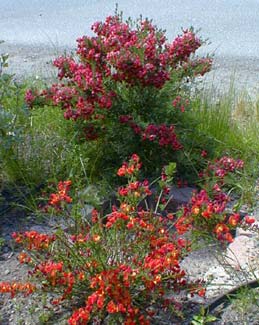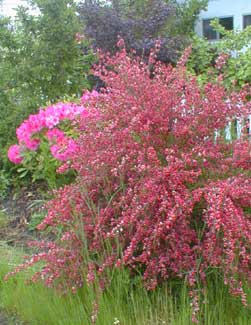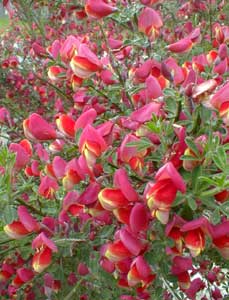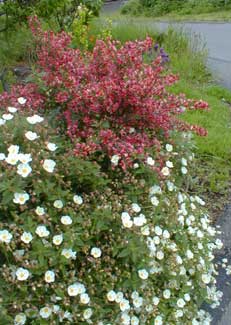
Burkwood's Broom
"O the broom, the bonnie, bonnie broom
The broom o' the Cowdenknowes."
-17th Century
Traditional Scottish
Border Ballad
Traditional Scottish
Border Ballad
The broom in the foreground in the first photo is the hybrid Cytisus scoparius x dallimorei 'Lena,' named for the German hybridizer. The broom in the rear is C. scoparius 'Burkwoodii,' named for the brothers Albert & Arthur Burkwood, famed plant developers in England in the early 20th Century.
These cultivars almost look like two of the same shrub in the first picturee. The appearance of their buds & flowers changes almost daily, & at one point during the month the blooms "converge" & are briefly the same color.
 But overall 'Lena's Broom' is more to the scarlet end when in bud, opening yellow with brilliant ruby wings. By contrast, 'Burkwood's' begins bright red with whispers of yellow, darkening to maroon or purple-burgundy, then when it is about through blooming for the year, fading to lavender, with brown wings. 'Burkwood's' growth rate is also much faster than 'Lena.'
But overall 'Lena's Broom' is more to the scarlet end when in bud, opening yellow with brilliant ruby wings. By contrast, 'Burkwood's' begins bright red with whispers of yellow, darkening to maroon or purple-burgundy, then when it is about through blooming for the year, fading to lavender, with brown wings. 'Burkwood's' growth rate is also much faster than 'Lena.'The same Burkwood broom is shown from the opposite side, in the second photo, a coukple yeard later (May 2005) when it had gotten enormous. The pink-flowering shrub further down the garden is Rhododendron 'Anna Rose Whitney.'
In 2002 the Burkwood started blooming earlier in May than did Lena's Broom, but in 2003 Burkwood was in full bloom the second week of May when the Lena was still just buds. They sort of take turns being first but 'Burkwood' is always more extremely vigorous, which is not to say 'Lena' isn't vigorous too, but comparatively speaking.
The flower close-up in the third photo shows the Burkwood's first week of full blossom. Whichever one blooms first will be the one finishing earliest in June, after almost exactly one month of flowers on each shrub.
 I remember the first time I saw a Burkwood's Broom. At least, I think it was probably Burkwood's, this being a very old cultivar & so probably the exact shrub I had at so young an age as eight. It was at a nursery called Furney's that over four decades years later still exists. There I was with my great-grampa when suddenly before my eyes was a purply-maroon flowering broom as big as myself, & my child's heart skipped a beat. I begged my grampa, who was buying all sorts of plants that day, to please get me that broom, please oh please. He said, "No, it's a weed, you don't want a weed."
I remember the first time I saw a Burkwood's Broom. At least, I think it was probably Burkwood's, this being a very old cultivar & so probably the exact shrub I had at so young an age as eight. It was at a nursery called Furney's that over four decades years later still exists. There I was with my great-grampa when suddenly before my eyes was a purply-maroon flowering broom as big as myself, & my child's heart skipped a beat. I begged my grampa, who was buying all sorts of plants that day, to please get me that broom, please oh please. He said, "No, it's a weed, you don't want a weed."I started crying, because I'd never seen anything so beautiful, densely covered with bright purply flowers, & it hurt my feelings that he'd call it a weed. The blooms didn't strike me as anything like the bright yellow roadside brooms, so it was unjust to call it a weed. Taking pity on my sadness over his having insulted that which I found beautiful, he finally caved in & said, "All right, but you better not plant it anywhere near my dahlias."
 It was the first thing bigger than pansies & rockery plants that I'd yet planted. I wanted it near my rockery about which I felt territorial, for which all decisions were made by me. The whole family was amused that I'd gotten fixated on what they regarded as only a big weed, but they wouldn't permit me to put it just anywhere I wanted.
It was the first thing bigger than pansies & rockery plants that I'd yet planted. I wanted it near my rockery about which I felt territorial, for which all decisions were made by me. The whole family was amused that I'd gotten fixated on what they regarded as only a big weed, but they wouldn't permit me to put it just anywhere I wanted.They okayed a spot far enough away from "important" plants but close enough to my rockery that I could feel it was an extension of "my" area. It bloomed so wonderfully & was a real centerpiece of attention, I think the family did gain a grudging fondness for it, though it was mainly a "family story" that I loved a weed so much. I wonder if it ever fully dawned on them it wasn't a weed at all, & it never did behave in the invasive manner they were expecting.
Both Lena's Broom & Burkwood's Broom separately received the Award of Garden Merit from the Royal Botanical Society. This is not an award given lightly, & says a lot for it. So you shouldn't go worrying about these broom cultivars being horrid & invasive in the manner of wild yellow brooms that the government planted alongside so many roadsides of temperate regions, to the everlasting regret of native species. AGM recipients are plants that have proven themselves over a period of time to be welcome garden companions, physically beautiful, & easy to grow.
Burkwood rooms very easily grow to five feet, & sometimes quite a bit larger, though brooms are entirely amenable to sheering to keep the size desired. The specimen shown in the first three photos is one of two Granny Artemis obtained as little one-gallon starts for our roadside gardens. It was three feet tall by its second year in the garden (in 2003), & four feet tall by 2004, & five feet by five feet by 2005, with only occasional sheerings along the way. In 2003 the second broom was planted in another roadside sun-garden; it is shown in the final photograph (May 2005) in the far side of a large white rockrose.
Broom is not actually terribly long-lived. Old scruffy specimens can often be rejuvenated by cutting them right to the ground. Ours are young enough shrubs that we haven't yet had to think about such a hard pruning.